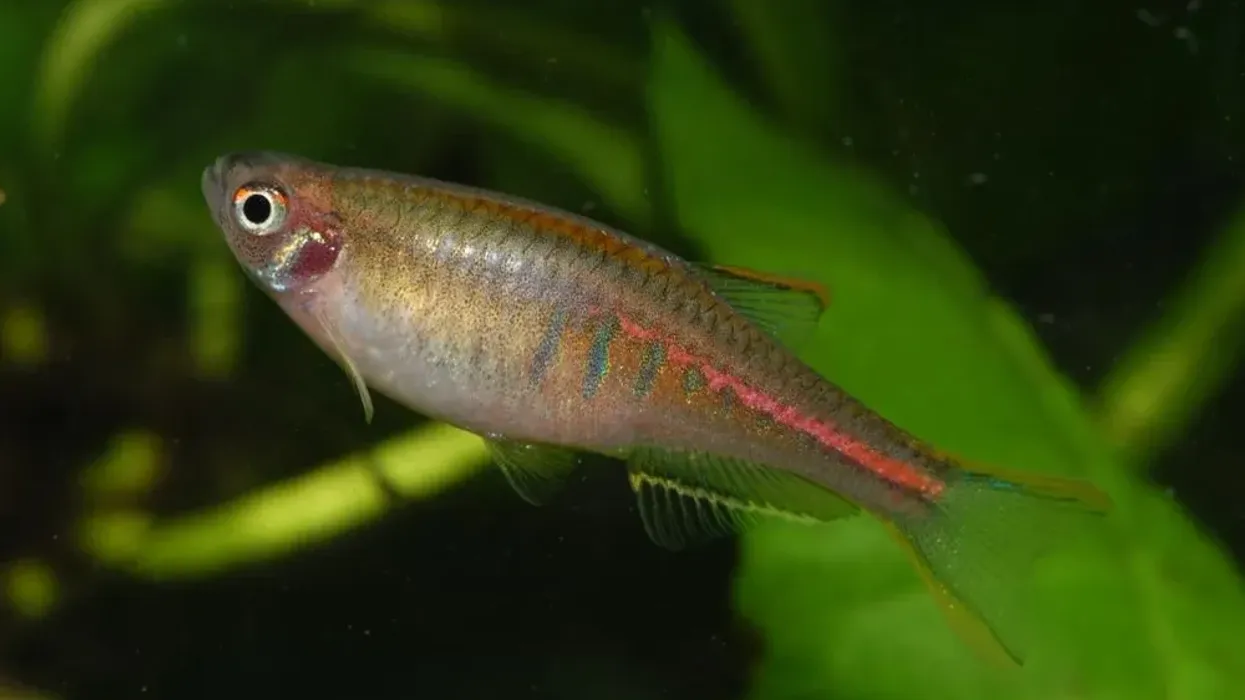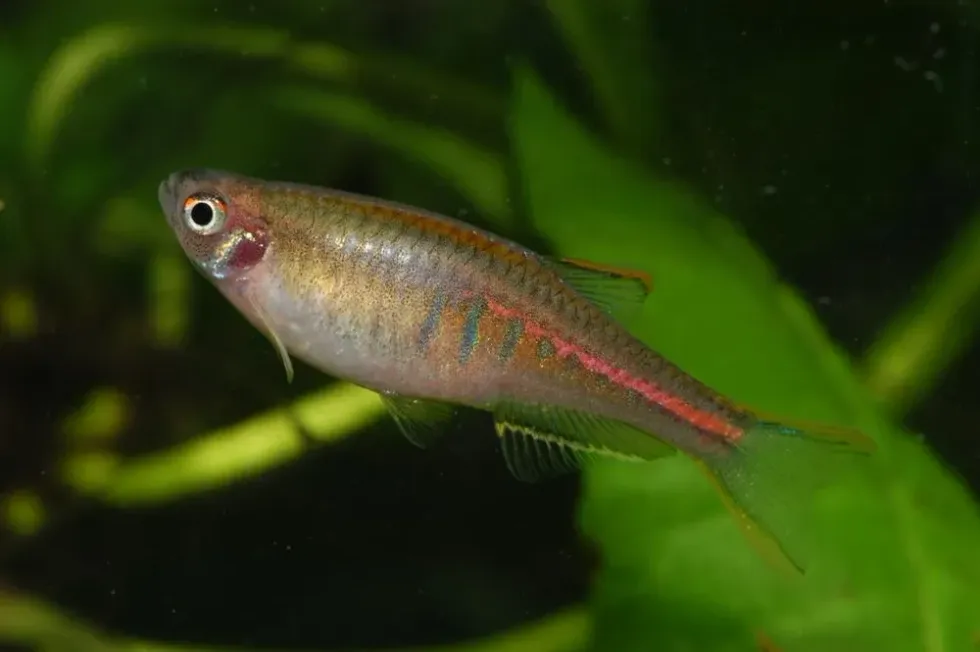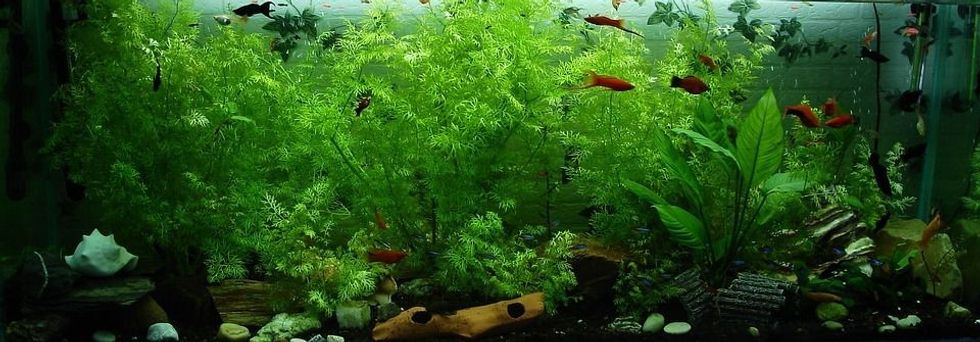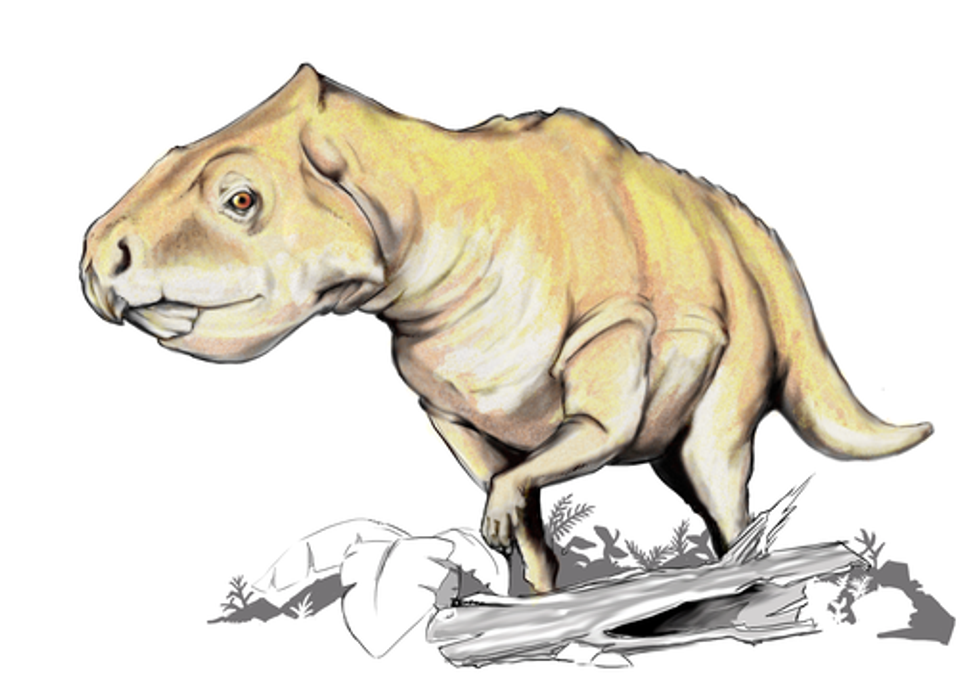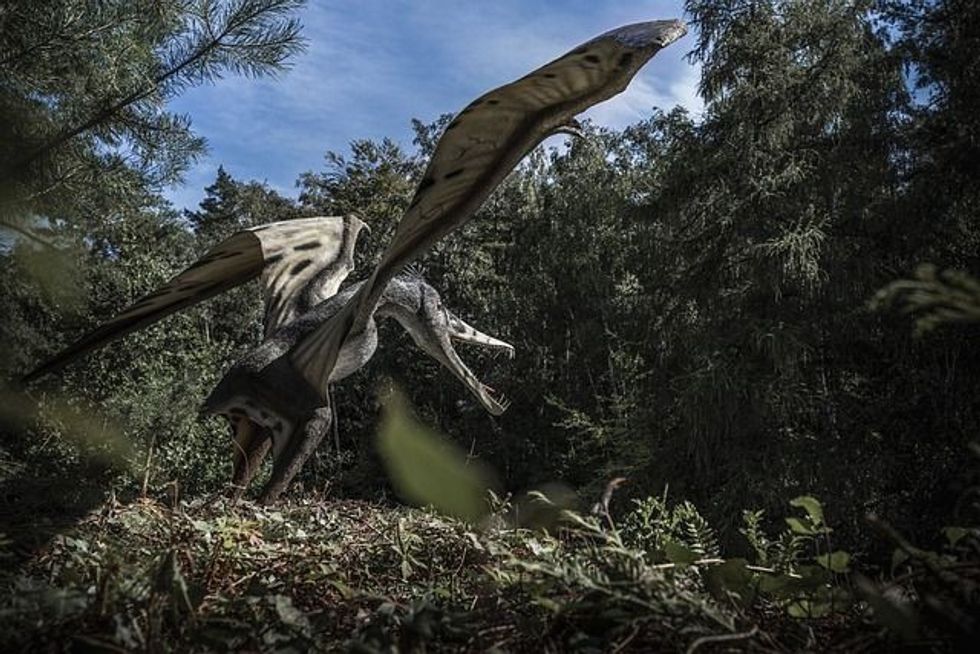The glowlight danio (Danio choprae) is a fish species that comes from the northern Myanmar region. It is found naturally in the Irrawaddy River and, since the 2000s, these fish have become common aquarium fish.
They belong to the Cyprinidae and Danio families and they closely resemble glowlight tetra fish in appearance. Despite this, they are more closely related to zebra danio fish.
They can be found with a variety of saturated colors on their bodies and are more colorful than most fish in the Danio family. Their colors include green, red, orange, gold, blue, silver, yellow, white, and black.
Glowlight danios feed on insects, insect larvae, flake foods, dwarf shrimp fry, and other small animals. In aquariums or tanks, they should not be kept with larger fish that might hurt them.
Males have more colorful bodies than females and fertilize eggs on the go while swimming. Glowlight Danios do not care for their eggs after laying them the eggs hatch into small fry in just 72 hours. The species is classified as Least Concern by the IUCN.
Learn more about glowlight danios here, and find out about other fish, such as the blue tang and the yellow tang.
Glowlight Danio Interesting Facts
What type of animal is a glowlight Danio?
A glowlight danio (Danio choprae) is a fish.
What class of animal does a glowlight Danio belong to?
The Danio choprai belongs to the 'fish' class of animals.
How many glowlight Danios are there in the world?
The exact number of Danio choprai fish in the world is not known. This is because glowlight danios have been largely kept as pet fish in personal fish tanks.
Where does a glowlight Danio live?
The Danio choprai or Glowlight Danio is a fish native to Northern Myanmar and is found mainly in shallow waters of hill streams. It is now bred as an aquarium and tank fish and for personal fish tanks.
What is a Glowlight Danio's habitat?
Glowlight danios (Danio choprae) live in the shallow waters of hill streams and are endemic to the Irrawaddy River in Myanmar. They exist at depths of 11.8-19.7 in (30-50 cm) in their freshwater habitat.
They are able able to coexist with the golden zebra loach and other peaceful fish in an aquarium tank. They are usually found near a good amount of rocks and substrate.
Who do glowlight Danios live with?
Glowlight danios (danio choprae) can live with other danio species or with the golden zebra loach and other small peaceful fish in an aquarium or fish tank.
How long does a glowlight Danio live?
Danio choprae fish live for an average of one to three years. With proper care, the glowlight Danio's lifespan can be increased to five to six years in an aquarium.
How do they reproduce?
Glowlight danio fish, much like other danio species reproduce by spawning and scattering eggs. The breeding of danios involves females laying between five and 20 eggs and free-swimming males fertilizing them.
These fish can spawn every 10 days and their fry hatch just three days after being laid. Glowlight danio fish (Danio choprae) do not care for their eggs after spawning and also tend to eat their eggs. This is why Danio choprae fish should be taken out of their tank while their fry choprae hatch.
What is their conservation status?
The conservation status of the glowlight Danio species, according to the International Union for Conservation of Nature is Least Concern.
Glowlight Danio Fun Facts
What does glowlight Danio look like?
Glowlight danios are considered to be the more beautiful versions of their cousin, the zebra danio rerio species of fish. It is a very small fish, weighing only about 0.0076-0.0088 oz (215-250 mg) and growing to a length of only 1 - 1.2 in (2.5 - 3 cm).
Their minuscule bodies consist of superbly decorated spots and bars of multiple colors such as green, red, orange, and gold. Their flanks also have shades of blue and black.
The glowlight Danio fish shows sexual dimorphism as females have larger and rounder bodies, with duller colors than males. This may be because males have to compete to attract females.
Their heads and fins show shades of red and blue and their fins display transparent silver, yellow, white, and black shades. It truly is a multicolored and stunning fish.

How cute are they?
Glowlight Danios are a very cute and beautiful species of fish. Their bodies are adorned with a variety of colors, such as green, red, gold, orange, and blue, that are very pleasing to the eye.
How do they communicate?
The glowlight Danio species communicates with their surroundings through olfaction, chemicals, and pheromones.
How big is a glowlight Danio?
Glowlight danios have tiny bodies with a length of about 1-1.2 in (2.5-3 cm), which makes them about 16-20 times smaller than a common carp fish.
How fast can a glowlight Danio swim?
Their exact speed is not known, but glowlight Danios can swim very quickly. When looking at them, they can look lethargic, but when needed, they are excellent and brisk swimmers. They can jump out of shallow waters easily and can quickly move through rocks to avoid predators.
How much does a glowlight Danio weigh?
Glowlight danios weigh about 0.0076-0.0088 oz (215-250 mg)
What are the male and female names of the species?
Males and females of the glowlight Danio fish species do not have specific names.
What would you call a baby glowlight Danio?
A baby glowlight Danio is called a fry.
What do they eat?
Glowlight danios eat insects, insect larvae, flake foods, dwarf shrimp fry, and other small animals.
Are they aggressive?
The glowlight Danio is a very shy and peaceful fish, but males can be aggressive towards other fish in their tank or their stream.
Would they make a good pet?
Yes, glowlight danios have become a mainstay as fish-tank pets since the early 2000s. They are actively farmed for this purpose.
Did you know...
The name that is widely used for the glowlight Danio is a bit of a misnomer. The fish was named Danio choprae in the year 1928 by scientist Dr. S. L. Hora for Dr. B. N. Chopra, who initially gathered the first specimen of the fish.
However, since the suffix 'ae' relates to female names in Latin, the scientific name was later changed to Danio choprai.
Glowlight danios, surprisingly, do not get their names from glow fish, which are a variety of zebra danio rerio fish. The zebra danio rerio fish happens to be a close cousin of glowlight danios, with both of them belonging to the family Cyprinidae.
Glowlight Danios get their names from glowlight tetra fish, to which they bear a resemblance in appearance.
Glowlight Danios are one of the most vivid and brightly colored species of the Danio family, with every color on their bodies being saturated to the maximum.
Glowlight Danios also often goes by the scientific name Celestichthys choprae.
Only between six and 10 glowlight Danio fish should be kept together in a single school. And at least five zebra danios should be kept together in a school. This practice needs to be observed since they are schooling fish.
The minimum tank size that is required for glowlight Danios is over 20 gallons. Proper glowlight danio care also includes maintaining a temperature of 61-79 F (16-26 C).
Also, the tank should have a pH of 6-8, and the carbonate hardness should be between 1-12. The tank size plays an important role since glowlight Danios are great jumpers. A tank size of more than 20 gallons prevents glowlight Danios from jumping out of their tank.
Glowlight danios belong to the order Cypriniformes and the genus Danio. The male of the species is more colorful than the female.
The body of a male is brighter, slender, and more colorful and the caudal fin, the dorsal fin, and the anal fin of the danio are all in different shades of color.
Their caudal fins tend to have a black and gold color, their dorsal fin has a yellow line, and their anal fin has a white line on it.
The breeding of danios has taken place for more than 72 years after they were first observed and classified. Now, the breeding of these aquatic animals is a business in its own right.
In their natural surroundings with plants, rocks, and substrate, danios have to be more active than in artificial aquarium surroundings. In the river, they must stay active to avoid being eaten by larger predators that habitually feed on them.
It does this by swimming through marine plants and finding holes in rocks or spaces between them. In an aquarium, these danios do not disturb the plants that are simply there for show.
The glowlight Danio has many great qualities which make it a great fish to have in an aquarium. It is endlessly adaptable and tough, it is largely peaceful and is extremely beautiful to look at.
It can be kept in a school with different species of fish and it leaves your aquarium plants undisturbed. Their aquariums or tanks also do not need to be heated, since the glowlight danio thrives at room temperature water and is extremely adaptive and tolerant to any changes in temperature.
What to keep with a glowlight Danio?
At a given time only a school of about 6 danios should be kept in a tank together. When designing an aquarium habitat or tank for glowlight danios, their compatibility with other fish should be accounted for.
For example, its compatibility with other Danio fishes is excellent which makes them excellent tankmates with each other, but not so much with larger size fishes like guppies. Other fish of smaller sizes can also make compatible tank mates with a glowlight Danio.
The glowlight Danio fish, being peaceful and shy, does well with other calm fish. They should not be kept with larger fish such as guppies, because they might end up harassing them.
They get along great with all other Danios, apart from the giant Danio, since it is a much bigger fish. Other suitable tank mates include anabantoids, tetras, loaches, livebearers, catfish, and rainbowfish.
An important step in glowlight Danio breeding is taking the Danios out of the tank after spawning to allow their eggs to hatch and become fry, otherwise, they might get eaten by the Danio adults. The nature around a glowlight Danio also is important, since a well-planted tank or aquarium keeps them happy.
A well-planted tank or aquarium should include plenty of rocks.
The feeding of glowlight danios is easier than most fish since they eat any dry food that is given to them, including flake food. Feeding Danios vegetable matter is also important. In their natural habitat, these danios eat insects and other larvae as food.
Does a glowlight Danio have teeth?
These fishes have between one and three sets of pharyngeal teeth located in their throat, and they have a bony plate near the pharyngeal bone's end to grind their food as well.
Here at Kidadl, we have carefully created lots of interesting family-friendly animal facts for everyone to discover! Learn more about some other fish including the neon tetra or Congo tetra.
You can even occupy yourself at home by drawing one on our glowlight Danio coloring pages.

